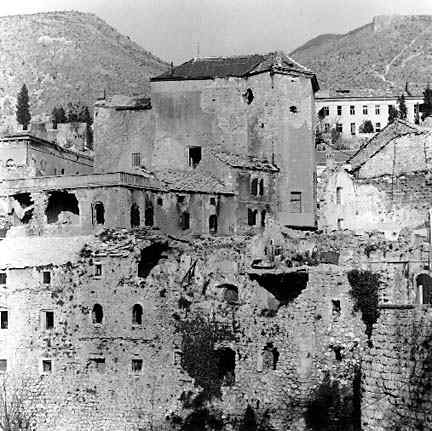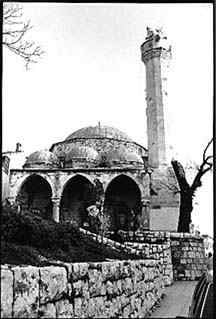




 |
 |
 |
 |
 |
|
| Contents Forward Backwards |
|
Mostar is truly a testament to the ravages and destruction of war. First bombed by Serbs occupying the surrounding hills in 1992 and 1993, then bombed and driven across the river by their Croat neighbors, the Muslim residents of Mostar experienced some of the worst fighting anywhere in Bosnia. Mostar, built by the Ottomans in the 15th century, is divided by the Neretva River, which ran beneath the 16th-century Stari Most (Old Bridge.) The bridge now lies in ruins on the bottom of the river, destroyed by Croat nationalists in 1993, along with every other bridge across the river. The UNHCR replaced it with a steel-cabled pedestrian walkway. Mostar is in a dry, rocky region of eastern Herzegovina, traditionally a Croat area. During the war, Bosnian Croat nationalists created their own statelet called Herzeg Bosna, and, following the Serb lead, ethnically cleansed the areas of all Muslims, including their neighbors in what is now called West Mostar. From the Adriatic coast in Croatia to the banks of the Neretva River in Mostar, there are well-stocked markets, modern hotels, and filled cafˇs. There are also phone and postal connections to the outside world. Across the Neretva River in East Mostar, however, lies the Bosnia of deprivation and siege. From Mostar to Tuzla in the northeast and Bihac in the northwest, food, fuel, medicine, and clothing were in desperately short supply. Phones sometimes worked, but never beyond the borders of government-controlled Bosnia. Mail could not go in or out except with aid workers. The Croat nationalists also followed the Serb example in setting up horrific concentration camps where the Muslim men of Mostar were sent. A year after the signing of the Dayton Accords and the formal dissolution of Herzeg Bosna, the city remains divided. |
  |